July 20-August 2 live war map: threat of Russian breakthrough looms west between Pokrovsk and Kostiantynivka
global.espreso.tv
Sat, 02 Aug 2025 12:58:00 +0300

In mid-July, Russian forces reduced their offensive activity by 10%, but quickly ramped it up again by the end of the month. Although enemy assaults peaked in May, with 5,690 attacks compared to 5,445 in July, the intensity remains high. In July, the occupiers seized nearly the same amount of territory as in June — over 560 km². Meanwhile, the Armed Forces of Ukraine continued a concerning trend: a decline in the number of Russian troops eliminated — just 33,200 in July, compared to at least 35,000 per month throughout last year.Over a third of all fighting still takes place in the Pokrovsk sector, with the Lyman sector steadily holding second place in intensity. At the same time, the intensity of fighting significantly decreased in the Sumy region and the Novopavlivka sector, while Russian activity shifted to the Siversk, Kramatorsk, Orikhiv, and Kherson sectors.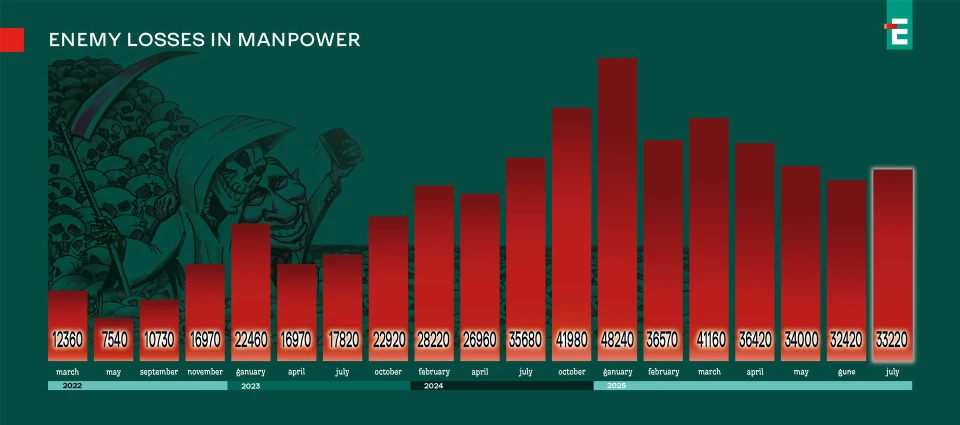 photo: EspresoTwo more anti-records for July are the lowest number of armored vehicles destroyed since the beginning of the war: 85 tanks and 140 armored personnel carriers. The fact is that the Russian troops now use armored vehicles extremely rarely, as there are few left and they are quickly destroyed. This trend will continue until the end of the war, in which we will no longer see large tank attacks.
photo: EspresoTwo more anti-records for July are the lowest number of armored vehicles destroyed since the beginning of the war: 85 tanks and 140 armored personnel carriers. The fact is that the Russian troops now use armored vehicles extremely rarely, as there are few left and they are quickly destroyed. This trend will continue until the end of the war, in which we will no longer see large tank attacks.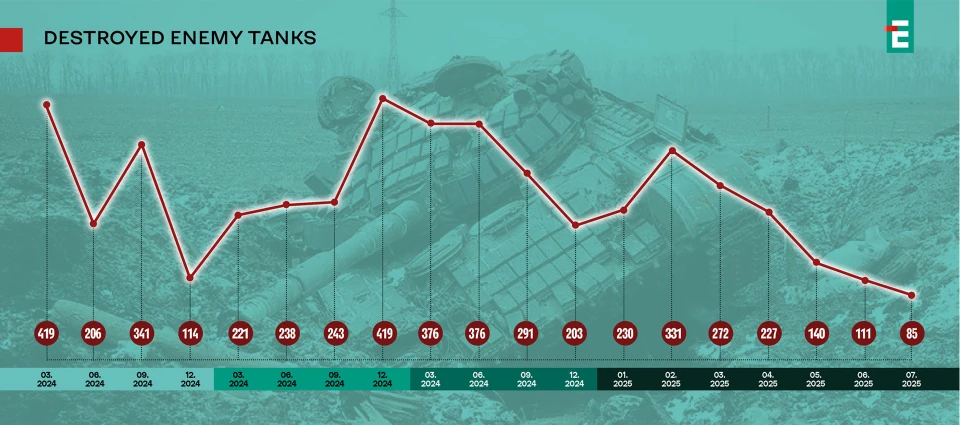 photo: EspresoIn contrast, the number of drones used in the war continues to rise. Russia launched 6,300 Shahed-type drones alone, 89% of which were shot down. However, more than 700 reached their targets — the highest number recorded since the start of the full-scale war. On average, 203 Shaheds were launched against Ukraine each day.
photo: EspresoIn contrast, the number of drones used in the war continues to rise. Russia launched 6,300 Shahed-type drones alone, 89% of which were shot down. However, more than 700 reached their targets — the highest number recorded since the start of the full-scale war. On average, 203 Shaheds were launched against Ukraine each day.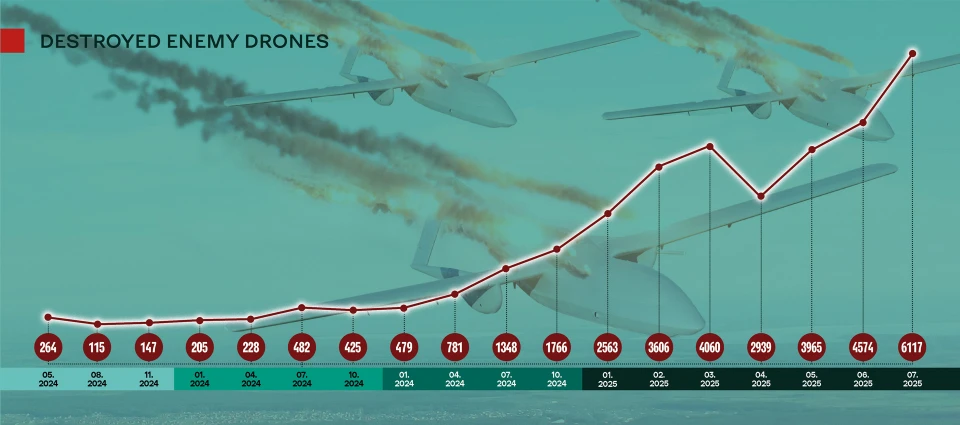 photo: EspresoLess than 30 km to ZaporizhzhiaDespite a fairly advantageous defensive position of the Defense Forces in Kamianske, Russian troops still managed to almost completely occupy the northern part of this village. Some Ukrainian soldiers are still engaged in fighting on the outskirts, but the enemy has already pushed further north and launched an assault on Stepnohirsk. At the same time, battles continue in Plavni, where Ukrainian forces still control half the village. Prolonged fighting for Stepnohirsk is likely in the near future, although Russian forces are unlikely to make excessive efforts to move closer to Zaporizhzhia itself. The current distance to the city’s first high-rise buildings is just 27 km in a straight line — close enough for large-scale terrorist attacks using their extensive arsenal.After capturing the Kamyanske–Orikhiv lateral road, Russian forces will most likely concentrate efforts on advancing toward Orikhiv — a heavily fortified but nearly destroyed town. In the coming days, the villages of Shcherbaky and Mali Shcherbaky are expected to come under attack.
photo: EspresoLess than 30 km to ZaporizhzhiaDespite a fairly advantageous defensive position of the Defense Forces in Kamianske, Russian troops still managed to almost completely occupy the northern part of this village. Some Ukrainian soldiers are still engaged in fighting on the outskirts, but the enemy has already pushed further north and launched an assault on Stepnohirsk. At the same time, battles continue in Plavni, where Ukrainian forces still control half the village. Prolonged fighting for Stepnohirsk is likely in the near future, although Russian forces are unlikely to make excessive efforts to move closer to Zaporizhzhia itself. The current distance to the city’s first high-rise buildings is just 27 km in a straight line — close enough for large-scale terrorist attacks using their extensive arsenal.After capturing the Kamyanske–Orikhiv lateral road, Russian forces will most likely concentrate efforts on advancing toward Orikhiv — a heavily fortified but nearly destroyed town. In the coming days, the villages of Shcherbaky and Mali Shcherbaky are expected to come under attack.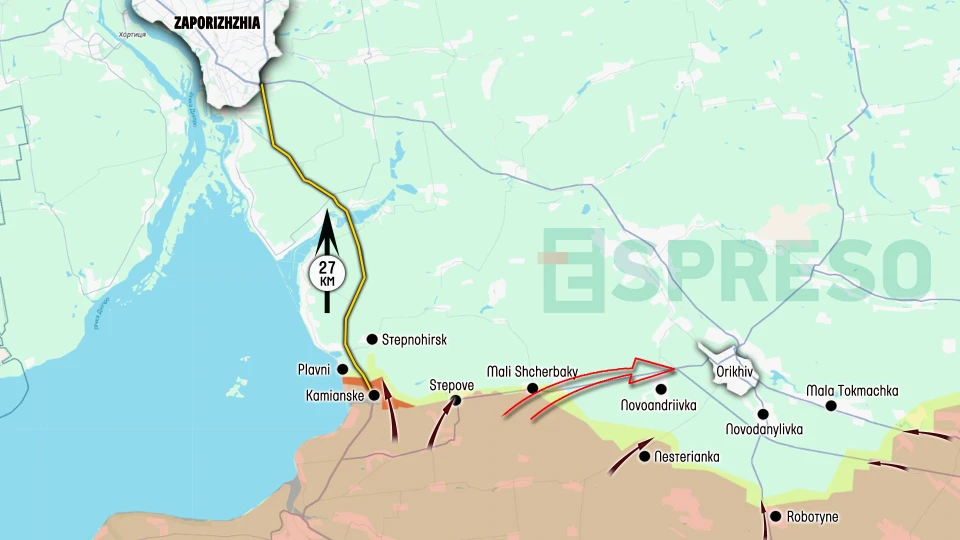 July 20-August 2 live war map, photo: EspresoHowever, a new serious threat has emerged on the horizon for the entire Zaporizhzhia front that could cause its collapse. This concerns an advance from the east, where after occupying Vuhledar on October 1 last year, the Russian troops pushed 50 km westward and reached Temyrivka, located on the administrative border between Zaporizhzhia and Donetsk regions. If the Russian forces are allowed to continue their advance, they will soon be able to encircle a significant part of Ukrainian defensive lines and reach the northern outskirts of Huliaipole.
July 20-August 2 live war map, photo: EspresoHowever, a new serious threat has emerged on the horizon for the entire Zaporizhzhia front that could cause its collapse. This concerns an advance from the east, where after occupying Vuhledar on October 1 last year, the Russian troops pushed 50 km westward and reached Temyrivka, located on the administrative border between Zaporizhzhia and Donetsk regions. If the Russian forces are allowed to continue their advance, they will soon be able to encircle a significant part of Ukrainian defensive lines and reach the northern outskirts of Huliaipole.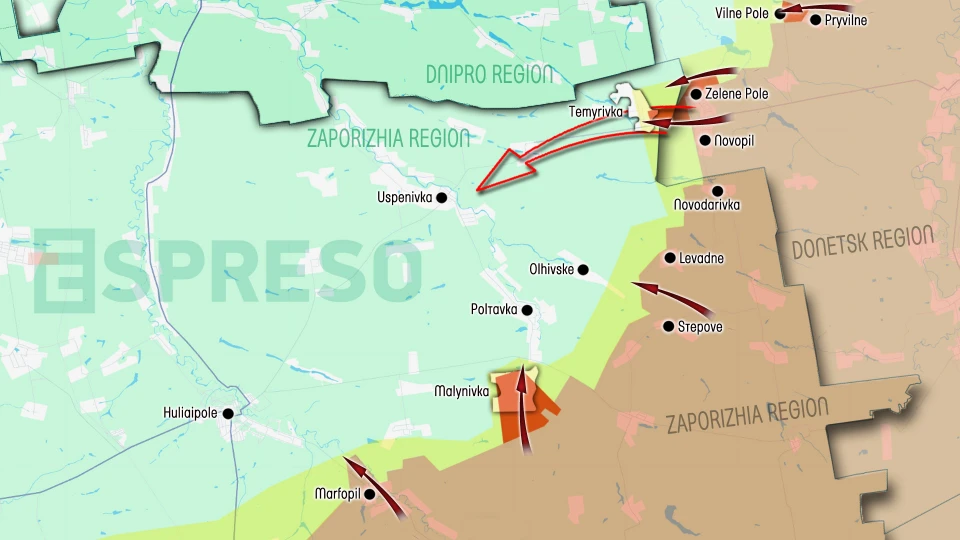 July 20-August 2 live war map, photo: EspresoNovopavlivka sector at risk of multiple encirclementsWhile some units of the Armed Forces of Ukraine are preparing to defend new defensive lines along the Novopavlivka–Ivanivka–Havrylivka axis, others are trying to retreat without falling into encirclement. After Russian forces made a rapid breakthrough into four villages — Voskresenka, Oleksandrohgrad, Zelenyi Hai, and Andriivka-Klevtsove — Ukrainian troops remaining in their positions found themselves in operational encirclement and are now seeking routes for withdrawal. Counterattacks are unlikely due to a lack of available forces in the area.The situation is particularly threatening near Voskresenka, where the enemy may soon fully close the encirclement. However, the Russian advance is stretched across a 100-kilometer front, and they lack sufficient manpower to maintain control over every section, leaving gaps along the frontline.
July 20-August 2 live war map, photo: EspresoNovopavlivka sector at risk of multiple encirclementsWhile some units of the Armed Forces of Ukraine are preparing to defend new defensive lines along the Novopavlivka–Ivanivka–Havrylivka axis, others are trying to retreat without falling into encirclement. After Russian forces made a rapid breakthrough into four villages — Voskresenka, Oleksandrohgrad, Zelenyi Hai, and Andriivka-Klevtsove — Ukrainian troops remaining in their positions found themselves in operational encirclement and are now seeking routes for withdrawal. Counterattacks are unlikely due to a lack of available forces in the area.The situation is particularly threatening near Voskresenka, where the enemy may soon fully close the encirclement. However, the Russian advance is stretched across a 100-kilometer front, and they lack sufficient manpower to maintain control over every section, leaving gaps along the frontline.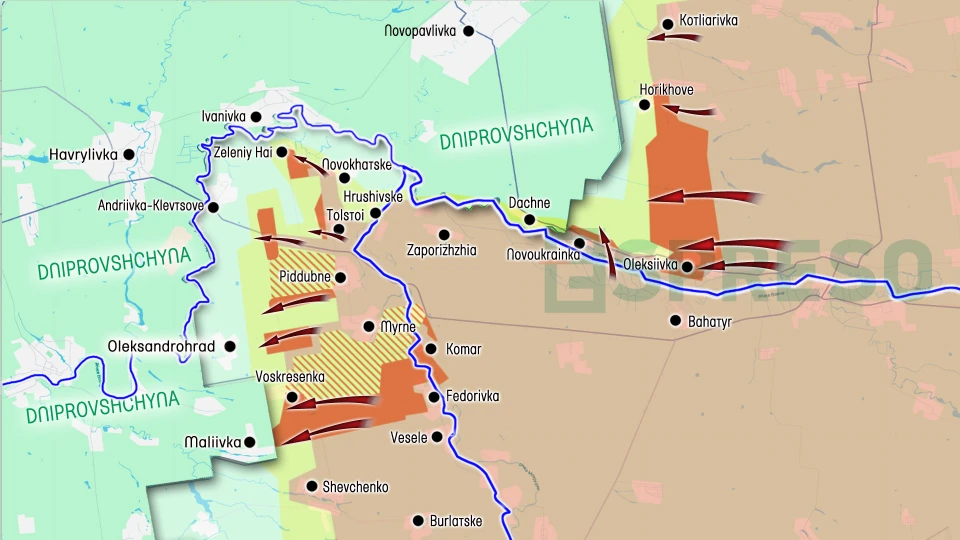 July 20-August 2 live war map, photo: EspresoAdditionally, the Russian troops are attempting to break through north of the Vovcha River near the village of Dachne, while simultaneously capturing the gray zone between Oleksiivka and Horikhove. However, here, on the border of Dnipropetrovsk and Donetsk regions, the Defense Forces are successfully holding defensive battles. Despite loud Russian claims a month ago about advancing into Dnipropetrovsk region, they have yet to achieve it.Battle for Pokrovsk reaches climaxDespite all efforts, the Russian Armed Forces have made no progress on the right flank of Pokrovsk’s defense, so they have thrown even more forces into a breakthrough attempt on the left flank. This threatens not only Pokrovsk and Kostiantynivka, but also Dobropillia and the entire northwestern part of Donetsk region. There, the Russian forces could achieve an operational breakthrough of the front, posing great risks for Ukraine. While one group of occupying Russian forces is fighting on the outskirts of Myroliubivka and Novoekonomichne to break through to Myrnohrad, another large group is pushing toward Dobropillia. They have already occupied Mayak and are attacking the road between the villages of Shakhove and Male Shakhove. This road would open the way for Russian forces to Dobropillia. It is currently unknown whether the Russians have enough strength to attack the town, but if they do, it will significantly disrupt our logistics and stretch our defensive efforts.Even more threatening is the breakthrough by Russian troops toward Rodynske, which they managed between two bodies of water, indicating weak defense organization at these positions. At the same time, the Russian forces have occupied Fedorivka and are advancing toward the northern outskirts of Rodynske. Thus, in the coming days, the occupiers will be able to attack Rodynske from both sides, making the village’s defense quite vulnerable. What’s worse, after Rodynske, a large open field stretches toward Hryshyne, which is key to Ukrainian logistics. The battles for Rodynske will determine the future of Pokrovsk’s defense, as without logistics, the Defense Forces of Ukraine will not be able to hold the city for long.
July 20-August 2 live war map, photo: EspresoAdditionally, the Russian troops are attempting to break through north of the Vovcha River near the village of Dachne, while simultaneously capturing the gray zone between Oleksiivka and Horikhove. However, here, on the border of Dnipropetrovsk and Donetsk regions, the Defense Forces are successfully holding defensive battles. Despite loud Russian claims a month ago about advancing into Dnipropetrovsk region, they have yet to achieve it.Battle for Pokrovsk reaches climaxDespite all efforts, the Russian Armed Forces have made no progress on the right flank of Pokrovsk’s defense, so they have thrown even more forces into a breakthrough attempt on the left flank. This threatens not only Pokrovsk and Kostiantynivka, but also Dobropillia and the entire northwestern part of Donetsk region. There, the Russian forces could achieve an operational breakthrough of the front, posing great risks for Ukraine. While one group of occupying Russian forces is fighting on the outskirts of Myroliubivka and Novoekonomichne to break through to Myrnohrad, another large group is pushing toward Dobropillia. They have already occupied Mayak and are attacking the road between the villages of Shakhove and Male Shakhove. This road would open the way for Russian forces to Dobropillia. It is currently unknown whether the Russians have enough strength to attack the town, but if they do, it will significantly disrupt our logistics and stretch our defensive efforts.Even more threatening is the breakthrough by Russian troops toward Rodynske, which they managed between two bodies of water, indicating weak defense organization at these positions. At the same time, the Russian forces have occupied Fedorivka and are advancing toward the northern outskirts of Rodynske. Thus, in the coming days, the occupiers will be able to attack Rodynske from both sides, making the village’s defense quite vulnerable. What’s worse, after Rodynske, a large open field stretches toward Hryshyne, which is key to Ukrainian logistics. The battles for Rodynske will determine the future of Pokrovsk’s defense, as without logistics, the Defense Forces of Ukraine will not be able to hold the city for long.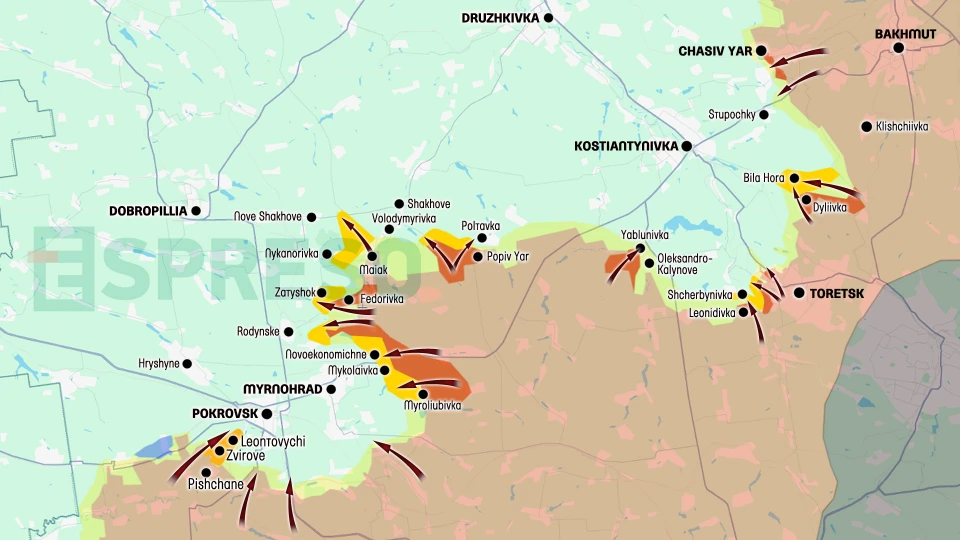 July 20-August 2 live war map, photo: EspresoKostiantynivka braces for defenseAlthough the Russian forces announced the capture of Chasiv Yar, this information is false — the Ukrainian Armed Forces still hold a significant part of the town, and Russian forces only recently seized a few positions near the beach and forest park area. Meanwhile, to the south, the occupiers are trying to break through along the road by attacking the village of Stupochky.On the southern flank, which is quite wide, the Russian army is steadily advancing from Dyliivka to Bila Hora, within Toretsk and Leonidivka, and, most painfully, in Yablunivka. Through Yablunivka, Russian occupiers could reach the shore of the Kleban-Byk Reservoir, which protects Kostiantynivka from the south and serves as a natural defense line. On the other hand, Ukraine has strong defensive redoubts here, so a quick breakthrough for the Russian troops is unlikely. Most likely, as on the Pokrovsk front, Russian invaders will approach the city closely but direct the main offensive through our rear, where they are currently attacking Popiv Yar and Poltavka. Here, the Russian forces aim to encircle Kostiantynivka by reaching Druzhkivka. However, it is unlikely that Russian forces can sustain simultaneous offensives on both Pokrovsk and Kostiantynivka — they will have to choose. For now, it is clear that the focus has shifted to Pokrovsk, meaning that all attacks near Kostiantynivka are likely preparatory in nature.
July 20-August 2 live war map, photo: EspresoKostiantynivka braces for defenseAlthough the Russian forces announced the capture of Chasiv Yar, this information is false — the Ukrainian Armed Forces still hold a significant part of the town, and Russian forces only recently seized a few positions near the beach and forest park area. Meanwhile, to the south, the occupiers are trying to break through along the road by attacking the village of Stupochky.On the southern flank, which is quite wide, the Russian army is steadily advancing from Dyliivka to Bila Hora, within Toretsk and Leonidivka, and, most painfully, in Yablunivka. Through Yablunivka, Russian occupiers could reach the shore of the Kleban-Byk Reservoir, which protects Kostiantynivka from the south and serves as a natural defense line. On the other hand, Ukraine has strong defensive redoubts here, so a quick breakthrough for the Russian troops is unlikely. Most likely, as on the Pokrovsk front, Russian invaders will approach the city closely but direct the main offensive through our rear, where they are currently attacking Popiv Yar and Poltavka. Here, the Russian forces aim to encircle Kostiantynivka by reaching Druzhkivka. However, it is unlikely that Russian forces can sustain simultaneous offensives on both Pokrovsk and Kostiantynivka — they will have to choose. For now, it is clear that the focus has shifted to Pokrovsk, meaning that all attacks near Kostiantynivka are likely preparatory in nature.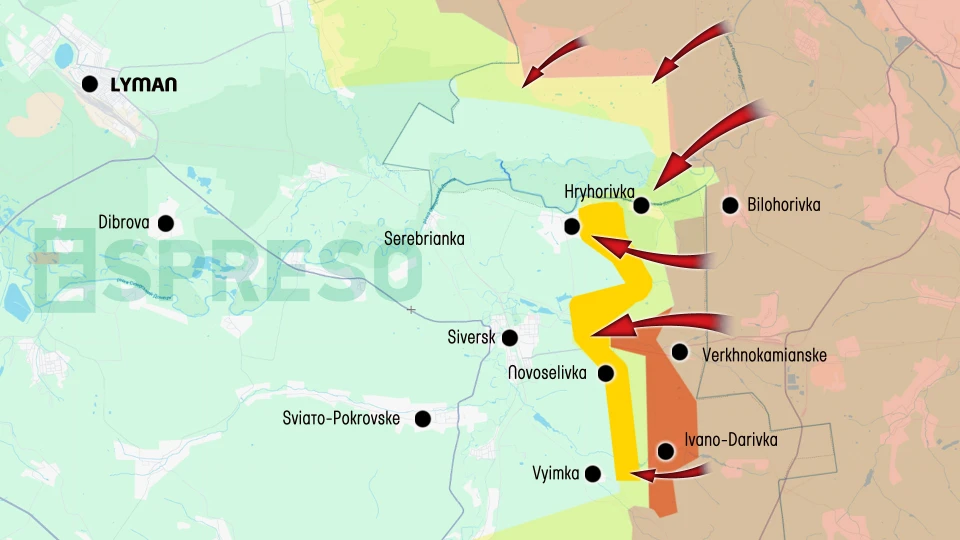 July 20-August 2 live war map, photo: EspresoAt the gates of Siversk fortressSiversk lies on the easternmost front and has held its ground since the war began. However, after the fall of Bilohorivka, where Ukrainian forces had held off the Russian army for over two years, Siversk's entire defensive line became vulnerable. The creeping offensive on Siversk has gained new momentum: Russian forces have captured Verkhnokamianske and Ivano-Dariivka and are continually attacking Vyiimka and Serebrianka in an effort to encircle Siversk from the flanks. Still, Russian troops’ numbers in this area are limited, making a rapid breakthrough unlikely. In recent days, Ukrainian forces repelled what was likely the largest armored assault on the entire front, destroying several tanks and 7–8 armored vehicles.
July 20-August 2 live war map, photo: EspresoAt the gates of Siversk fortressSiversk lies on the easternmost front and has held its ground since the war began. However, after the fall of Bilohorivka, where Ukrainian forces had held off the Russian army for over two years, Siversk's entire defensive line became vulnerable. The creeping offensive on Siversk has gained new momentum: Russian forces have captured Verkhnokamianske and Ivano-Dariivka and are continually attacking Vyiimka and Serebrianka in an effort to encircle Siversk from the flanks. Still, Russian troops’ numbers in this area are limited, making a rapid breakthrough unlikely. In recent days, Ukrainian forces repelled what was likely the largest armored assault on the entire front, destroying several tanks and 7–8 armored vehicles.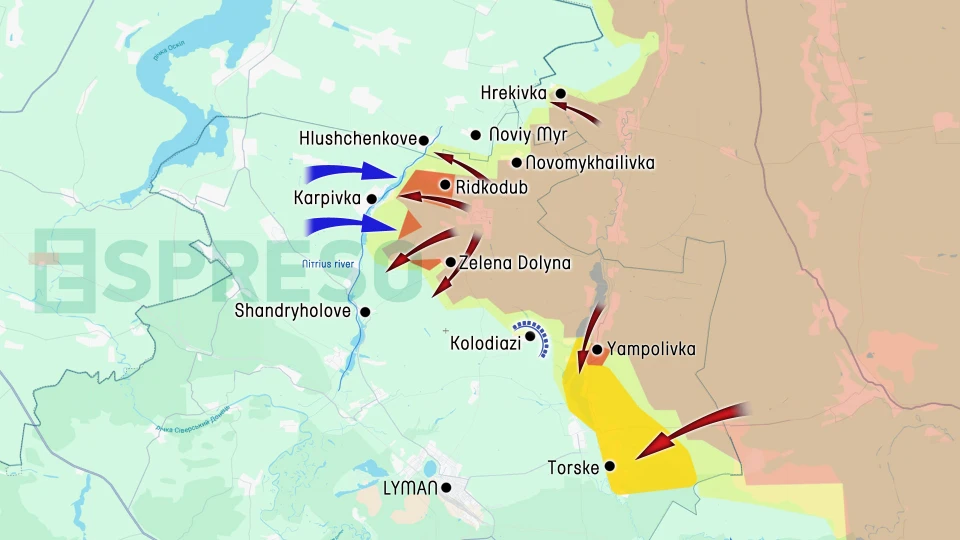 July 20-August 2 live war map, photo: EspresoLyman holds the lineThe 3rd Army Corps, which holds a 120-kilometer front from Lyman to Borova, has presented its first results following reorganization. The conclusion: although the Lyman front is the most difficult after Pokrovsk, Russian advances there remain minimal. Over the past 10 days, they managed only to expand the gray zone near Torske and occupy Ridkodub. Meanwhile, Ukrainian counterattacks pushed them back from Karpivka, and their offensive on Shandryholove has stalled. This clearly shows that if the Ukrainian Armed Forces can establish effective organizational coordination, our soldiers, even when heavily outnumbered, are capable of waging high-quality defensive operations.
July 20-August 2 live war map, photo: EspresoLyman holds the lineThe 3rd Army Corps, which holds a 120-kilometer front from Lyman to Borova, has presented its first results following reorganization. The conclusion: although the Lyman front is the most difficult after Pokrovsk, Russian advances there remain minimal. Over the past 10 days, they managed only to expand the gray zone near Torske and occupy Ridkodub. Meanwhile, Ukrainian counterattacks pushed them back from Karpivka, and their offensive on Shandryholove has stalled. This clearly shows that if the Ukrainian Armed Forces can establish effective organizational coordination, our soldiers, even when heavily outnumbered, are capable of waging high-quality defensive operations.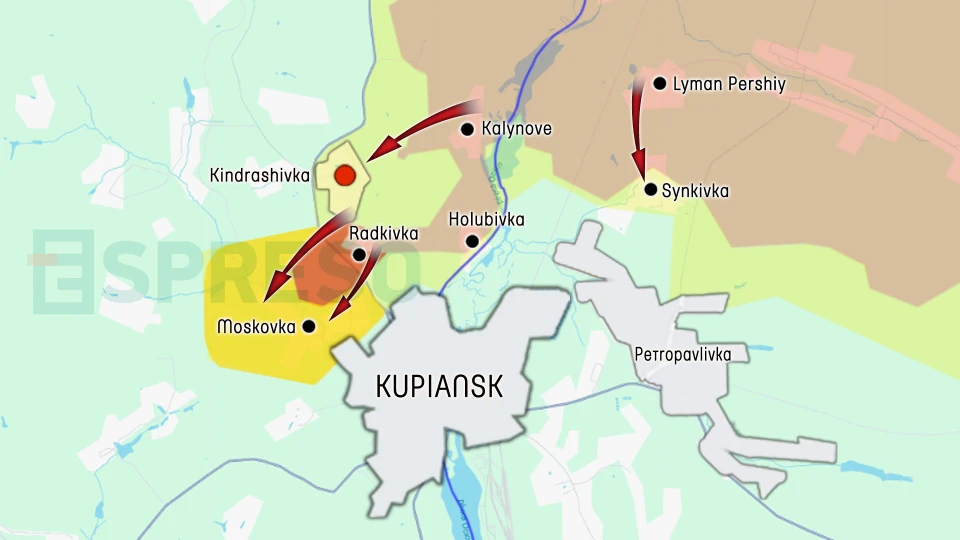 July 20-August 2 live war map, photo: EspresoRussian forces advance toward Kupiansk’s northern outskirtsRussian forces have captured Radkivka and advanced westward toward Moskovka. They have effectively reached the northern outskirts of Kupiansk. If Ukrainian forces fail to push them back, the invaders may build up strength in the area and eventually launch urban combat, not on the left, but on the right bank of the Oskil River. However, the situation is not yet critical, as the Russian troops still lack sufficient forces for a full-scale assault on the town, and transferring troops from the left to the right bank remains a significant challenge.
July 20-August 2 live war map, photo: EspresoRussian forces advance toward Kupiansk’s northern outskirtsRussian forces have captured Radkivka and advanced westward toward Moskovka. They have effectively reached the northern outskirts of Kupiansk. If Ukrainian forces fail to push them back, the invaders may build up strength in the area and eventually launch urban combat, not on the left, but on the right bank of the Oskil River. However, the situation is not yet critical, as the Russian troops still lack sufficient forces for a full-scale assault on the town, and transferring troops from the left to the right bank remains a significant challenge.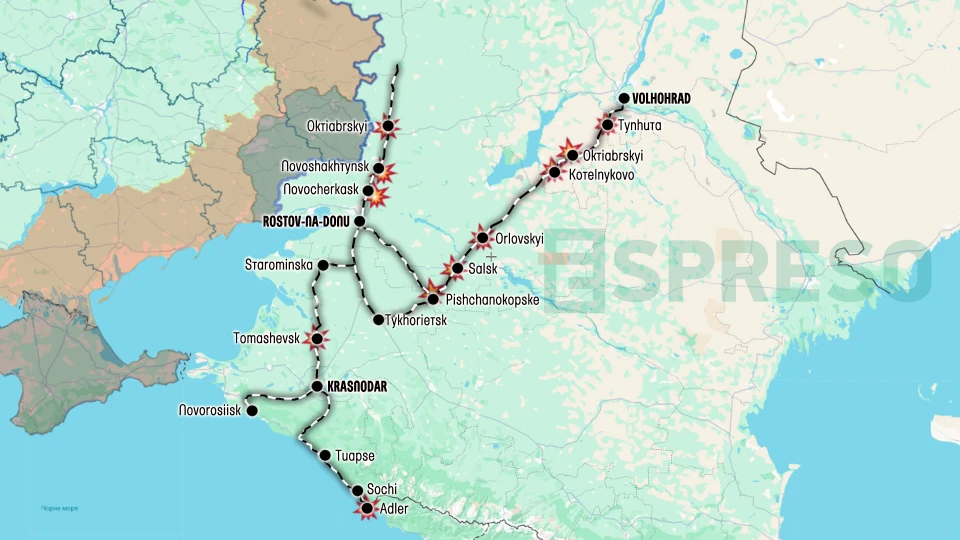 July 20-August 2 live war map, photo: EspresoRussia’s beach logistics under attack by Ukrainian forcesOver ten days, Ukrainian drones struck dozens of key railway junctions in southern Russia, critical for the front in the Donetsk region. Specifically targeted were the Volgograd–Rostov and Krasnodar–Rostov lines. More than 10 railway hubs and stations were hit, largely paralyzing railway operations, right at the peak of the beach season, when most Russians travel to Black Sea beaches in Krasnodar Krai. On top of that, there was a hacker attack on Aeroflot airlines. Russian logistics, which had reached peak load at this time, suffered a heavy blow and began to collapse.The maps are based on information provided by the General Staff of the Armed Forces of Ukraine, as well as other open and verified sources. However, they are not fully precise and only approximately reflect trends in the combat zone.
July 20-August 2 live war map, photo: EspresoRussia’s beach logistics under attack by Ukrainian forcesOver ten days, Ukrainian drones struck dozens of key railway junctions in southern Russia, critical for the front in the Donetsk region. Specifically targeted were the Volgograd–Rostov and Krasnodar–Rostov lines. More than 10 railway hubs and stations were hit, largely paralyzing railway operations, right at the peak of the beach season, when most Russians travel to Black Sea beaches in Krasnodar Krai. On top of that, there was a hacker attack on Aeroflot airlines. Russian logistics, which had reached peak load at this time, suffered a heavy blow and began to collapse.The maps are based on information provided by the General Staff of the Armed Forces of Ukraine, as well as other open and verified sources. However, they are not fully precise and only approximately reflect trends in the combat zone.
 photo: EspresoTwo more anti-records for July are the lowest number of armored vehicles destroyed since the beginning of the war: 85 tanks and 140 armored personnel carriers. The fact is that the Russian troops now use armored vehicles extremely rarely, as there are few left and they are quickly destroyed. This trend will continue until the end of the war, in which we will no longer see large tank attacks.
photo: EspresoTwo more anti-records for July are the lowest number of armored vehicles destroyed since the beginning of the war: 85 tanks and 140 armored personnel carriers. The fact is that the Russian troops now use armored vehicles extremely rarely, as there are few left and they are quickly destroyed. This trend will continue until the end of the war, in which we will no longer see large tank attacks. photo: EspresoIn contrast, the number of drones used in the war continues to rise. Russia launched 6,300 Shahed-type drones alone, 89% of which were shot down. However, more than 700 reached their targets — the highest number recorded since the start of the full-scale war. On average, 203 Shaheds were launched against Ukraine each day.
photo: EspresoIn contrast, the number of drones used in the war continues to rise. Russia launched 6,300 Shahed-type drones alone, 89% of which were shot down. However, more than 700 reached their targets — the highest number recorded since the start of the full-scale war. On average, 203 Shaheds were launched against Ukraine each day. photo: EspresoLess than 30 km to ZaporizhzhiaDespite a fairly advantageous defensive position of the Defense Forces in Kamianske, Russian troops still managed to almost completely occupy the northern part of this village. Some Ukrainian soldiers are still engaged in fighting on the outskirts, but the enemy has already pushed further north and launched an assault on Stepnohirsk. At the same time, battles continue in Plavni, where Ukrainian forces still control half the village. Prolonged fighting for Stepnohirsk is likely in the near future, although Russian forces are unlikely to make excessive efforts to move closer to Zaporizhzhia itself. The current distance to the city’s first high-rise buildings is just 27 km in a straight line — close enough for large-scale terrorist attacks using their extensive arsenal.After capturing the Kamyanske–Orikhiv lateral road, Russian forces will most likely concentrate efforts on advancing toward Orikhiv — a heavily fortified but nearly destroyed town. In the coming days, the villages of Shcherbaky and Mali Shcherbaky are expected to come under attack.
photo: EspresoLess than 30 km to ZaporizhzhiaDespite a fairly advantageous defensive position of the Defense Forces in Kamianske, Russian troops still managed to almost completely occupy the northern part of this village. Some Ukrainian soldiers are still engaged in fighting on the outskirts, but the enemy has already pushed further north and launched an assault on Stepnohirsk. At the same time, battles continue in Plavni, where Ukrainian forces still control half the village. Prolonged fighting for Stepnohirsk is likely in the near future, although Russian forces are unlikely to make excessive efforts to move closer to Zaporizhzhia itself. The current distance to the city’s first high-rise buildings is just 27 km in a straight line — close enough for large-scale terrorist attacks using their extensive arsenal.After capturing the Kamyanske–Orikhiv lateral road, Russian forces will most likely concentrate efforts on advancing toward Orikhiv — a heavily fortified but nearly destroyed town. In the coming days, the villages of Shcherbaky and Mali Shcherbaky are expected to come under attack. July 20-August 2 live war map, photo: EspresoHowever, a new serious threat has emerged on the horizon for the entire Zaporizhzhia front that could cause its collapse. This concerns an advance from the east, where after occupying Vuhledar on October 1 last year, the Russian troops pushed 50 km westward and reached Temyrivka, located on the administrative border between Zaporizhzhia and Donetsk regions. If the Russian forces are allowed to continue their advance, they will soon be able to encircle a significant part of Ukrainian defensive lines and reach the northern outskirts of Huliaipole.
July 20-August 2 live war map, photo: EspresoHowever, a new serious threat has emerged on the horizon for the entire Zaporizhzhia front that could cause its collapse. This concerns an advance from the east, where after occupying Vuhledar on October 1 last year, the Russian troops pushed 50 km westward and reached Temyrivka, located on the administrative border between Zaporizhzhia and Donetsk regions. If the Russian forces are allowed to continue their advance, they will soon be able to encircle a significant part of Ukrainian defensive lines and reach the northern outskirts of Huliaipole. July 20-August 2 live war map, photo: EspresoNovopavlivka sector at risk of multiple encirclementsWhile some units of the Armed Forces of Ukraine are preparing to defend new defensive lines along the Novopavlivka–Ivanivka–Havrylivka axis, others are trying to retreat without falling into encirclement. After Russian forces made a rapid breakthrough into four villages — Voskresenka, Oleksandrohgrad, Zelenyi Hai, and Andriivka-Klevtsove — Ukrainian troops remaining in their positions found themselves in operational encirclement and are now seeking routes for withdrawal. Counterattacks are unlikely due to a lack of available forces in the area.The situation is particularly threatening near Voskresenka, where the enemy may soon fully close the encirclement. However, the Russian advance is stretched across a 100-kilometer front, and they lack sufficient manpower to maintain control over every section, leaving gaps along the frontline.
July 20-August 2 live war map, photo: EspresoNovopavlivka sector at risk of multiple encirclementsWhile some units of the Armed Forces of Ukraine are preparing to defend new defensive lines along the Novopavlivka–Ivanivka–Havrylivka axis, others are trying to retreat without falling into encirclement. After Russian forces made a rapid breakthrough into four villages — Voskresenka, Oleksandrohgrad, Zelenyi Hai, and Andriivka-Klevtsove — Ukrainian troops remaining in their positions found themselves in operational encirclement and are now seeking routes for withdrawal. Counterattacks are unlikely due to a lack of available forces in the area.The situation is particularly threatening near Voskresenka, where the enemy may soon fully close the encirclement. However, the Russian advance is stretched across a 100-kilometer front, and they lack sufficient manpower to maintain control over every section, leaving gaps along the frontline. July 20-August 2 live war map, photo: EspresoAdditionally, the Russian troops are attempting to break through north of the Vovcha River near the village of Dachne, while simultaneously capturing the gray zone between Oleksiivka and Horikhove. However, here, on the border of Dnipropetrovsk and Donetsk regions, the Defense Forces are successfully holding defensive battles. Despite loud Russian claims a month ago about advancing into Dnipropetrovsk region, they have yet to achieve it.Battle for Pokrovsk reaches climaxDespite all efforts, the Russian Armed Forces have made no progress on the right flank of Pokrovsk’s defense, so they have thrown even more forces into a breakthrough attempt on the left flank. This threatens not only Pokrovsk and Kostiantynivka, but also Dobropillia and the entire northwestern part of Donetsk region. There, the Russian forces could achieve an operational breakthrough of the front, posing great risks for Ukraine. While one group of occupying Russian forces is fighting on the outskirts of Myroliubivka and Novoekonomichne to break through to Myrnohrad, another large group is pushing toward Dobropillia. They have already occupied Mayak and are attacking the road between the villages of Shakhove and Male Shakhove. This road would open the way for Russian forces to Dobropillia. It is currently unknown whether the Russians have enough strength to attack the town, but if they do, it will significantly disrupt our logistics and stretch our defensive efforts.Even more threatening is the breakthrough by Russian troops toward Rodynske, which they managed between two bodies of water, indicating weak defense organization at these positions. At the same time, the Russian forces have occupied Fedorivka and are advancing toward the northern outskirts of Rodynske. Thus, in the coming days, the occupiers will be able to attack Rodynske from both sides, making the village’s defense quite vulnerable. What’s worse, after Rodynske, a large open field stretches toward Hryshyne, which is key to Ukrainian logistics. The battles for Rodynske will determine the future of Pokrovsk’s defense, as without logistics, the Defense Forces of Ukraine will not be able to hold the city for long.
July 20-August 2 live war map, photo: EspresoAdditionally, the Russian troops are attempting to break through north of the Vovcha River near the village of Dachne, while simultaneously capturing the gray zone between Oleksiivka and Horikhove. However, here, on the border of Dnipropetrovsk and Donetsk regions, the Defense Forces are successfully holding defensive battles. Despite loud Russian claims a month ago about advancing into Dnipropetrovsk region, they have yet to achieve it.Battle for Pokrovsk reaches climaxDespite all efforts, the Russian Armed Forces have made no progress on the right flank of Pokrovsk’s defense, so they have thrown even more forces into a breakthrough attempt on the left flank. This threatens not only Pokrovsk and Kostiantynivka, but also Dobropillia and the entire northwestern part of Donetsk region. There, the Russian forces could achieve an operational breakthrough of the front, posing great risks for Ukraine. While one group of occupying Russian forces is fighting on the outskirts of Myroliubivka and Novoekonomichne to break through to Myrnohrad, another large group is pushing toward Dobropillia. They have already occupied Mayak and are attacking the road between the villages of Shakhove and Male Shakhove. This road would open the way for Russian forces to Dobropillia. It is currently unknown whether the Russians have enough strength to attack the town, but if they do, it will significantly disrupt our logistics and stretch our defensive efforts.Even more threatening is the breakthrough by Russian troops toward Rodynske, which they managed between two bodies of water, indicating weak defense organization at these positions. At the same time, the Russian forces have occupied Fedorivka and are advancing toward the northern outskirts of Rodynske. Thus, in the coming days, the occupiers will be able to attack Rodynske from both sides, making the village’s defense quite vulnerable. What’s worse, after Rodynske, a large open field stretches toward Hryshyne, which is key to Ukrainian logistics. The battles for Rodynske will determine the future of Pokrovsk’s defense, as without logistics, the Defense Forces of Ukraine will not be able to hold the city for long. July 20-August 2 live war map, photo: EspresoKostiantynivka braces for defenseAlthough the Russian forces announced the capture of Chasiv Yar, this information is false — the Ukrainian Armed Forces still hold a significant part of the town, and Russian forces only recently seized a few positions near the beach and forest park area. Meanwhile, to the south, the occupiers are trying to break through along the road by attacking the village of Stupochky.On the southern flank, which is quite wide, the Russian army is steadily advancing from Dyliivka to Bila Hora, within Toretsk and Leonidivka, and, most painfully, in Yablunivka. Through Yablunivka, Russian occupiers could reach the shore of the Kleban-Byk Reservoir, which protects Kostiantynivka from the south and serves as a natural defense line. On the other hand, Ukraine has strong defensive redoubts here, so a quick breakthrough for the Russian troops is unlikely. Most likely, as on the Pokrovsk front, Russian invaders will approach the city closely but direct the main offensive through our rear, where they are currently attacking Popiv Yar and Poltavka. Here, the Russian forces aim to encircle Kostiantynivka by reaching Druzhkivka. However, it is unlikely that Russian forces can sustain simultaneous offensives on both Pokrovsk and Kostiantynivka — they will have to choose. For now, it is clear that the focus has shifted to Pokrovsk, meaning that all attacks near Kostiantynivka are likely preparatory in nature.
July 20-August 2 live war map, photo: EspresoKostiantynivka braces for defenseAlthough the Russian forces announced the capture of Chasiv Yar, this information is false — the Ukrainian Armed Forces still hold a significant part of the town, and Russian forces only recently seized a few positions near the beach and forest park area. Meanwhile, to the south, the occupiers are trying to break through along the road by attacking the village of Stupochky.On the southern flank, which is quite wide, the Russian army is steadily advancing from Dyliivka to Bila Hora, within Toretsk and Leonidivka, and, most painfully, in Yablunivka. Through Yablunivka, Russian occupiers could reach the shore of the Kleban-Byk Reservoir, which protects Kostiantynivka from the south and serves as a natural defense line. On the other hand, Ukraine has strong defensive redoubts here, so a quick breakthrough for the Russian troops is unlikely. Most likely, as on the Pokrovsk front, Russian invaders will approach the city closely but direct the main offensive through our rear, where they are currently attacking Popiv Yar and Poltavka. Here, the Russian forces aim to encircle Kostiantynivka by reaching Druzhkivka. However, it is unlikely that Russian forces can sustain simultaneous offensives on both Pokrovsk and Kostiantynivka — they will have to choose. For now, it is clear that the focus has shifted to Pokrovsk, meaning that all attacks near Kostiantynivka are likely preparatory in nature. July 20-August 2 live war map, photo: EspresoAt the gates of Siversk fortressSiversk lies on the easternmost front and has held its ground since the war began. However, after the fall of Bilohorivka, where Ukrainian forces had held off the Russian army for over two years, Siversk's entire defensive line became vulnerable. The creeping offensive on Siversk has gained new momentum: Russian forces have captured Verkhnokamianske and Ivano-Dariivka and are continually attacking Vyiimka and Serebrianka in an effort to encircle Siversk from the flanks. Still, Russian troops’ numbers in this area are limited, making a rapid breakthrough unlikely. In recent days, Ukrainian forces repelled what was likely the largest armored assault on the entire front, destroying several tanks and 7–8 armored vehicles.
July 20-August 2 live war map, photo: EspresoAt the gates of Siversk fortressSiversk lies on the easternmost front and has held its ground since the war began. However, after the fall of Bilohorivka, where Ukrainian forces had held off the Russian army for over two years, Siversk's entire defensive line became vulnerable. The creeping offensive on Siversk has gained new momentum: Russian forces have captured Verkhnokamianske and Ivano-Dariivka and are continually attacking Vyiimka and Serebrianka in an effort to encircle Siversk from the flanks. Still, Russian troops’ numbers in this area are limited, making a rapid breakthrough unlikely. In recent days, Ukrainian forces repelled what was likely the largest armored assault on the entire front, destroying several tanks and 7–8 armored vehicles. July 20-August 2 live war map, photo: EspresoLyman holds the lineThe 3rd Army Corps, which holds a 120-kilometer front from Lyman to Borova, has presented its first results following reorganization. The conclusion: although the Lyman front is the most difficult after Pokrovsk, Russian advances there remain minimal. Over the past 10 days, they managed only to expand the gray zone near Torske and occupy Ridkodub. Meanwhile, Ukrainian counterattacks pushed them back from Karpivka, and their offensive on Shandryholove has stalled. This clearly shows that if the Ukrainian Armed Forces can establish effective organizational coordination, our soldiers, even when heavily outnumbered, are capable of waging high-quality defensive operations.
July 20-August 2 live war map, photo: EspresoLyman holds the lineThe 3rd Army Corps, which holds a 120-kilometer front from Lyman to Borova, has presented its first results following reorganization. The conclusion: although the Lyman front is the most difficult after Pokrovsk, Russian advances there remain minimal. Over the past 10 days, they managed only to expand the gray zone near Torske and occupy Ridkodub. Meanwhile, Ukrainian counterattacks pushed them back from Karpivka, and their offensive on Shandryholove has stalled. This clearly shows that if the Ukrainian Armed Forces can establish effective organizational coordination, our soldiers, even when heavily outnumbered, are capable of waging high-quality defensive operations. July 20-August 2 live war map, photo: EspresoRussian forces advance toward Kupiansk’s northern outskirtsRussian forces have captured Radkivka and advanced westward toward Moskovka. They have effectively reached the northern outskirts of Kupiansk. If Ukrainian forces fail to push them back, the invaders may build up strength in the area and eventually launch urban combat, not on the left, but on the right bank of the Oskil River. However, the situation is not yet critical, as the Russian troops still lack sufficient forces for a full-scale assault on the town, and transferring troops from the left to the right bank remains a significant challenge.
July 20-August 2 live war map, photo: EspresoRussian forces advance toward Kupiansk’s northern outskirtsRussian forces have captured Radkivka and advanced westward toward Moskovka. They have effectively reached the northern outskirts of Kupiansk. If Ukrainian forces fail to push them back, the invaders may build up strength in the area and eventually launch urban combat, not on the left, but on the right bank of the Oskil River. However, the situation is not yet critical, as the Russian troops still lack sufficient forces for a full-scale assault on the town, and transferring troops from the left to the right bank remains a significant challenge. July 20-August 2 live war map, photo: EspresoRussia’s beach logistics under attack by Ukrainian forcesOver ten days, Ukrainian drones struck dozens of key railway junctions in southern Russia, critical for the front in the Donetsk region. Specifically targeted were the Volgograd–Rostov and Krasnodar–Rostov lines. More than 10 railway hubs and stations were hit, largely paralyzing railway operations, right at the peak of the beach season, when most Russians travel to Black Sea beaches in Krasnodar Krai. On top of that, there was a hacker attack on Aeroflot airlines. Russian logistics, which had reached peak load at this time, suffered a heavy blow and began to collapse.The maps are based on information provided by the General Staff of the Armed Forces of Ukraine, as well as other open and verified sources. However, they are not fully precise and only approximately reflect trends in the combat zone.
July 20-August 2 live war map, photo: EspresoRussia’s beach logistics under attack by Ukrainian forcesOver ten days, Ukrainian drones struck dozens of key railway junctions in southern Russia, critical for the front in the Donetsk region. Specifically targeted were the Volgograd–Rostov and Krasnodar–Rostov lines. More than 10 railway hubs and stations were hit, largely paralyzing railway operations, right at the peak of the beach season, when most Russians travel to Black Sea beaches in Krasnodar Krai. On top of that, there was a hacker attack on Aeroflot airlines. Russian logistics, which had reached peak load at this time, suffered a heavy blow and began to collapse.The maps are based on information provided by the General Staff of the Armed Forces of Ukraine, as well as other open and verified sources. However, they are not fully precise and only approximately reflect trends in the combat zone. 








